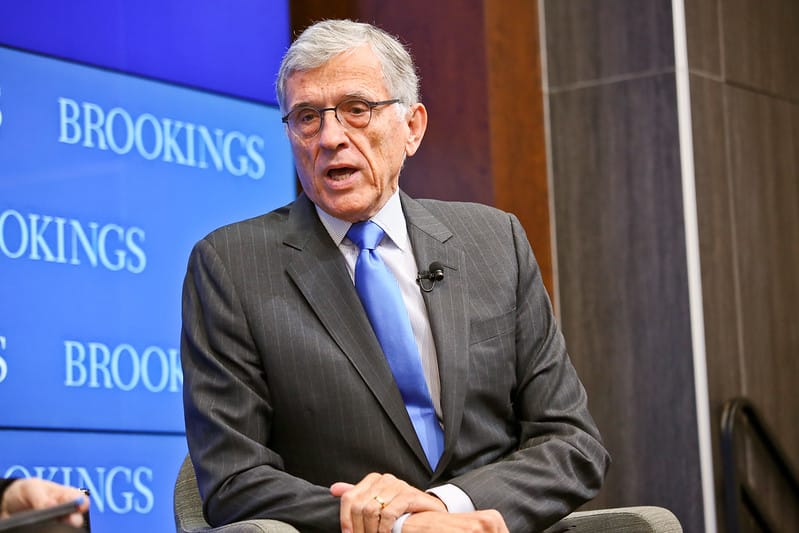Former FCC Chief Tom Wheeler Proposes Spectrum Sharing, Communications and Disabilities, 5G in South Korea
In a Brookings Institute post, Former Federal Communications Commission Chairman Tom Wheeler, recommends spectrum sharing to minimize the spectrum shortage caused by increased demand for wireless radio frequencies. As of yet, spectrum is a rivalrous asset. If one party owns it, another party cannot
Jericho Casper

In a Brookings Institute post, Former Federal Communications Commission Chairman Tom Wheeler, recommends spectrum sharing to minimize the spectrum shortage caused by increased demand for wireless radio frequencies.
As of yet, spectrum is a rivalrous asset. If one party owns it, another party cannot utilize it. Yet, digital technology has changed that equation by allowing for multiple users to share the same piece of spectrum without causing signal interference.
One of the components that is much-discussed with 5G technology and in other forms of wireless communications is dynamic spectrum sharing. That vehicle might help accomplish some of Wheeler’s vision.
According to Wheeler, the way in which spectrum sharing works is exemplified by the Wi-Fi in our homes. We use the same piece of unlicensed spectrum as our neighbors without interfering with each other. The neighbors are non-rivalrous users because each can use the same piece of spectrum without limiting anyone else.
Before it sends out a packet of data, Wi-Fi devices “listen” to see if another device is transmitting. If other data is transmitting, your Wi-Fi device will wait until there is an open “millisecond-sized slot” before pushing some of your data into that unused space.
“Such sharing could possibly put a dent into, or even eliminate, the spectrum shortage,” said Wheeler.
FCC to discuss Communications and Video Accessibility Action milestones
On Wednesday, the FCC released its 2020 biennial report (PDF) to Congress, as required by the Communications and Video Accessibility Act. Thursday is the tenth anniversary (PDF) of the CVAA and the FCC is set to hold a public program in celebration.
CVAA was authored by Sen. Edward Markey, D-Mass. (then a representative), in 2010. It attempted to address the gap in access created by the proliferation of services like online video, text messaging, and email.
Until the CVAA became law, rapidly emerging technologies and services were not governed by federal accessibility protections. CVAA has helped to build a more accessible telecommunications world for people with disabilities.
In its Wednesday report, the FCC found that over the last two years, additional improvements in promoting the accessibility of tech have flourished. The report cited continued efforts to innovate and incorporate features that enable improved access to smartphones, such as speech-to-text and text-to-speech technology, voice assistants, and screen readers.
Nonetheless, accessibility gaps continue to exist for mobile phones with low-end features, functions, and prices for people who are blind. Further, certain apps that provide telecommunications services are not readable by screen readers.
Sudden embrace of 5G coincides with drop of Samsung Note 20
South Korean operators reported the addition of 800,000 new 5G customers in August, a 64 percent increase from the previous month. New Street analysts noted that this is the second-highest level of 5G customer growth since the technology was first launched.
The Samsung Note 20 was released during the month, and is likely responsible for the increased demand.
“We expect continued strength in net customer adds in the coming months, particularly with the Apple launch expected sometime within the next month,” New Street analysts wrote in a report to investors this week, LightReading reported.
On Tuesday, Apple announced it would host an event October 13 where it is widely expected to announce its 5G iPhones. The company’s invitation to the event sported the phrase “Hi, Speed.”
The release promises to lead to another wave of 5G customers, especially in the United States, where over half of the market relies on Apple phones.
The New Street analysts wrote that the South Korea’s sales of 5G represent a positive for the global industry, saying “The August data confirms that 5G demand remains intact and 5G tariffs are to date remaining stable providing a 20 percent uplift to average revenue per user. As a result, we continue with our positive view on the industry.”









Member discussion